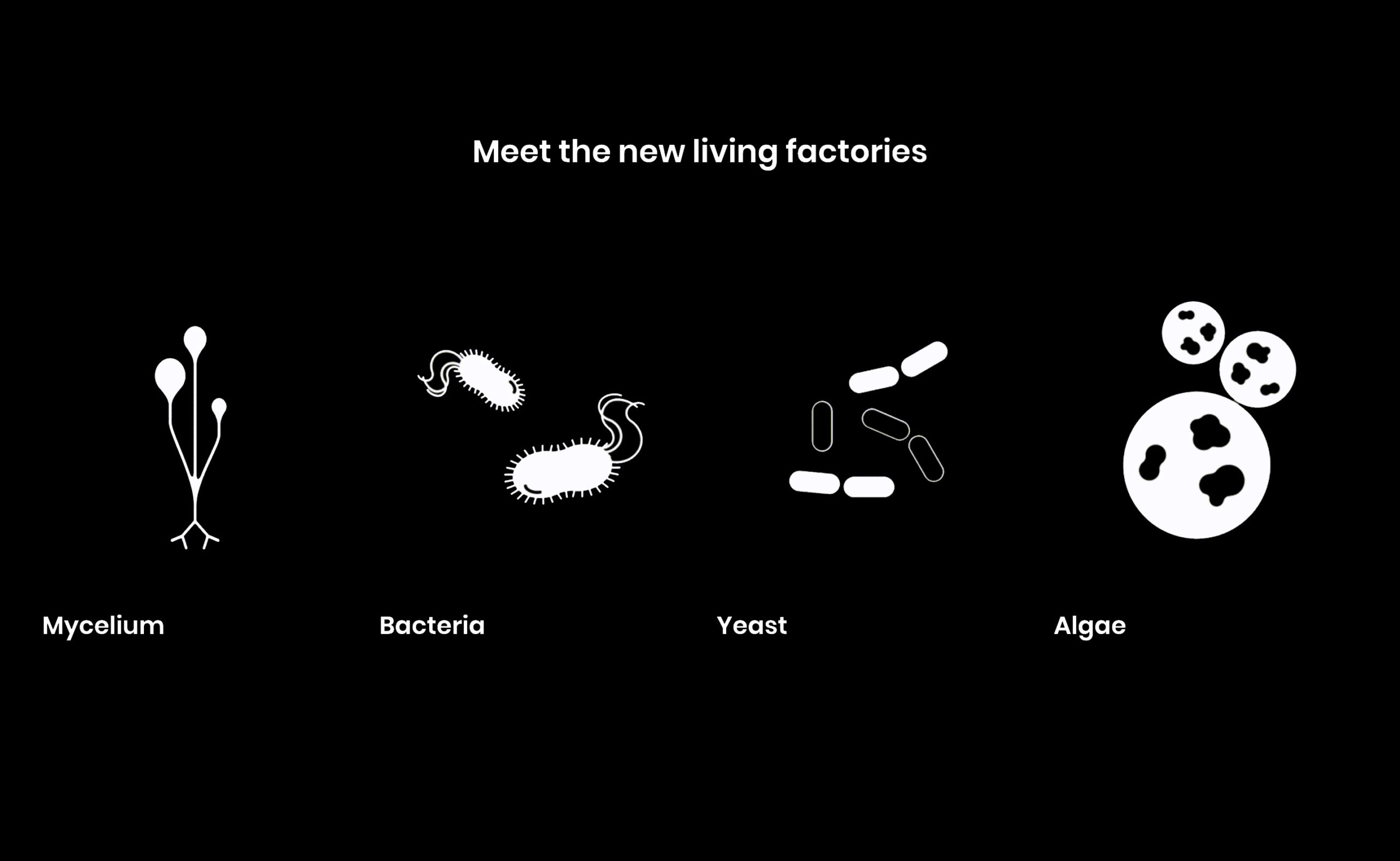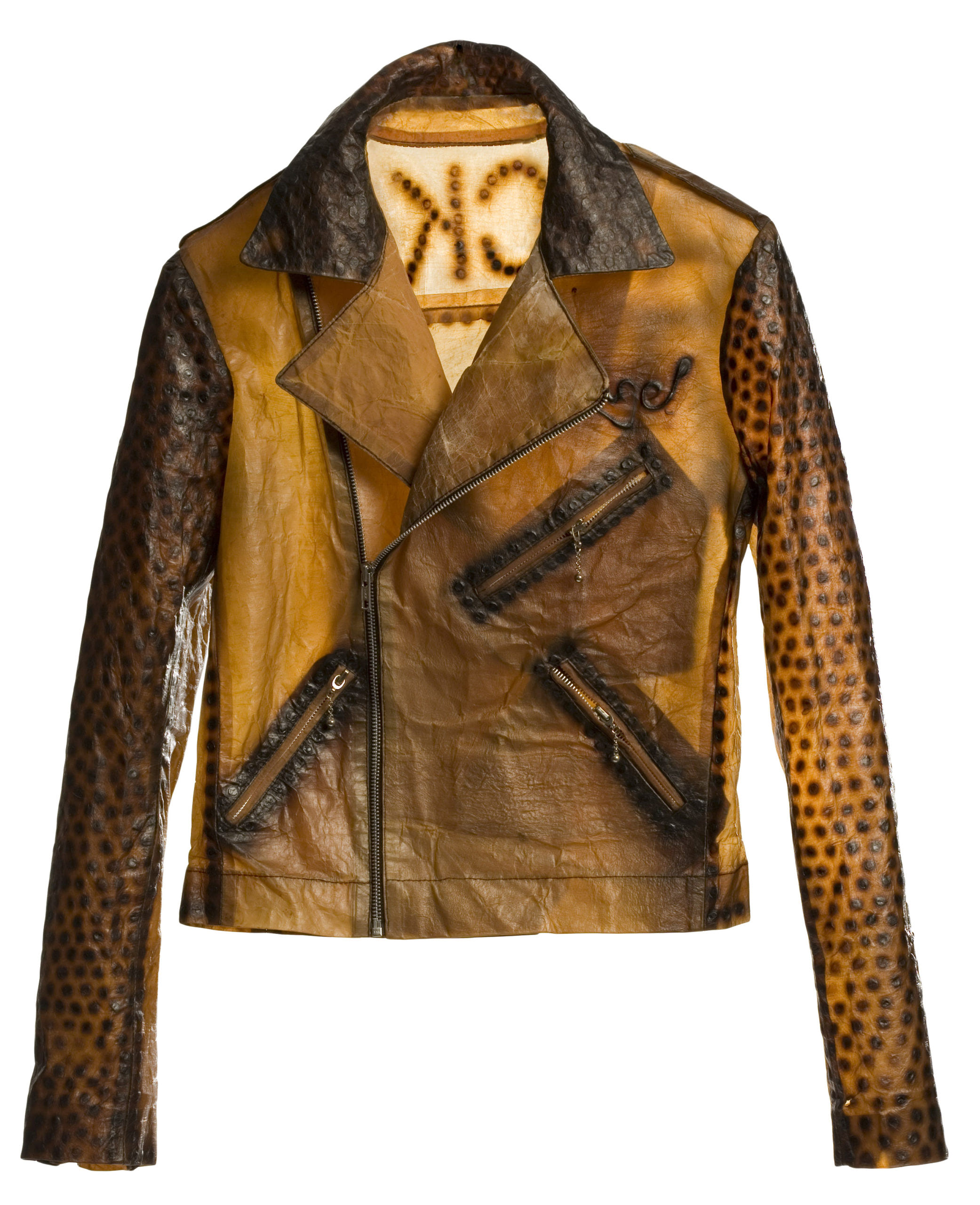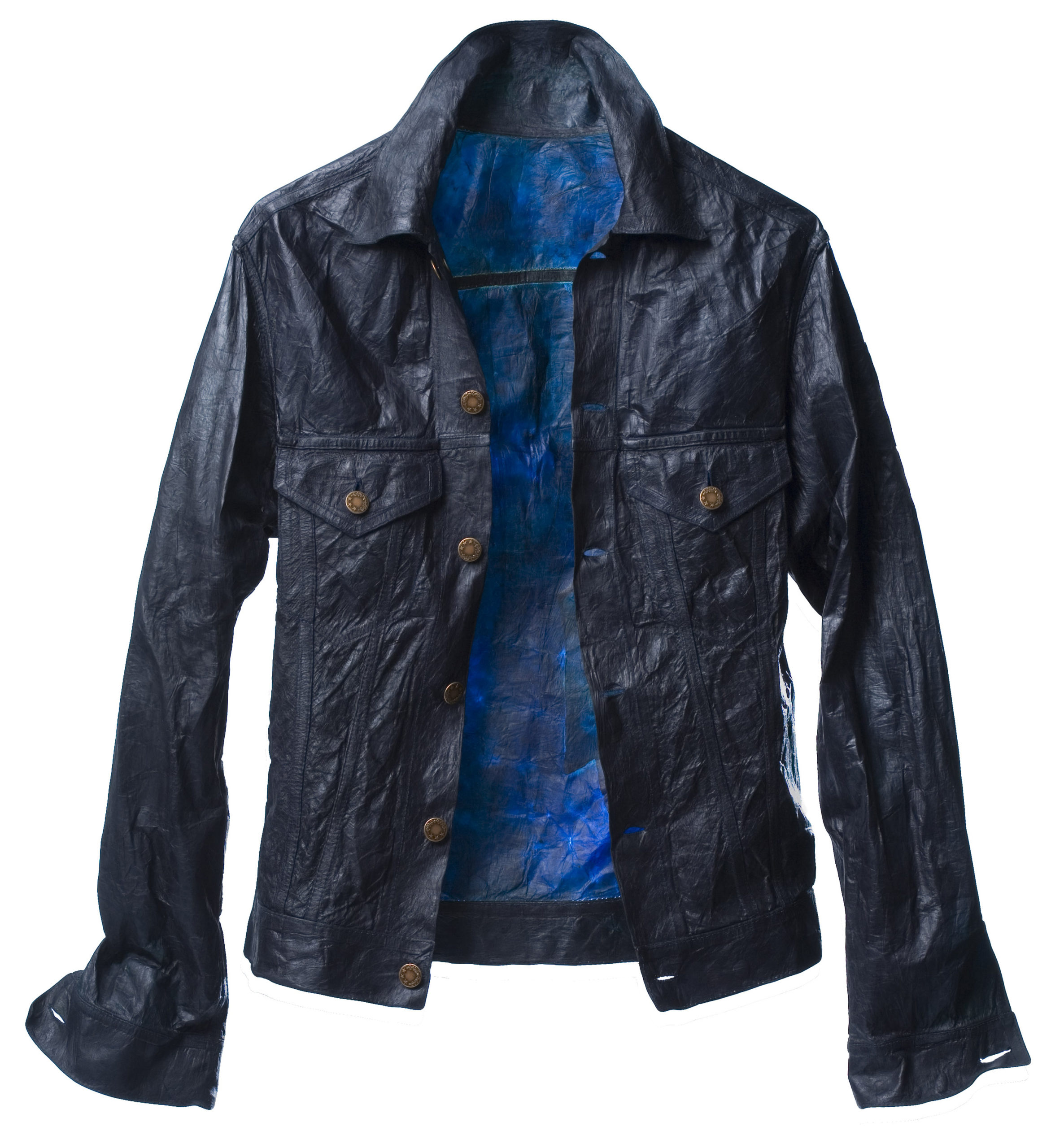Biotechnology is nearly as old as humanity itself. The food you eat and the pets you love? You can thank our ancestors for kickstarting the agricultural revolution, using artificial selection for crops, livestock, and other domesticated animals. And our modern civilization would hardly be imaginable without the fermentation processes that gave us beer, wine, and cheese.
Biotechnology is spreading into every aspect of our lives—from our everyday products to our materials. In fact, Biotechnology already plays an important role in the textile industry. Enzymes are used routinely to wash and bleach textiles, to give jeans a denim look or to prevent wool from shrinking. Now, a new wave of biotechnology could take this a step further.
In a not-so-distant future, our clothes will be made and dyed by ‘living factories’ (such as mycelium, bacteria, yeast and algae), ditching many of the chemical processes that make the textile industry one of the most polluting industries in the world.
Many players around the world are already disrupting the textile industry with biofabrication. On the forefront of this material revolution is fashion designer turned biofabrication pioneer Suzanne Lee, who is nurturing a global community of innovators growing materials at Biofabricate.
Lee coined the term ‘biocouture’ in 2004 to describe her pioneering research growing clothing using living organisms. In 2007 Lee published the groundbreaking book, ‘Fashioning The Future: Tomorrow’s Wardrobe’, where, for the first time, new technologies for fashion and textiles were captured and mapped out. It remains a key text for designers, scientists and engineers wanting to glimpse the future of wearable technology.
In 2014 she became chief creative officer at Modern Meadow, a New York-based biotech startup growing collagen to manufacture animal-free bioleather materials. In that same year Lee launched the Biofabricate Summit in New York (and as of 2019 in London), bringing together artists, scientists, and designers to share projects and discuss the growing concept of biology-as-technology.
Today, as the founder and CEO of Biofabricate, Lee has established a platform for collaboration in design and biology to grow the future of sustainable materials for consumer products.
We caught up with innovator-in-chief Suzanne Lee and discussed evolving world’s first biocreative consultancy, what it means to bring new biomaterials, biodesign and biofabrication to fashion, beauty, sport and luxury, and how to take biomaterials from the lab to the market. So buckle up, and enjoy the ride.
Biomimicry, Biobased, Biomaterials, Biofabrication; many of these terms are now finding their way into mainstream communication (which I guess is a good thing) yet, it simultaneously creates a set of buzz-word terminology, which may undermine or, even pass by, the urgency of developing such innovative methods and materials today. How do you relate to this?
The increasing use of the prefix ‘bio’ we find is actually creating confusion in many sectors both on the industry side and on the consumer side. These words are not widely understood and, worse, frequently incorrectly applied.
It’s a daily challenge in our consulting work at Biofabricate. We find it concerning because decision-makers are taking action based upon these misunderstandings. This is especially true where people are looking to biology for sustainable solutions or alternatives to petrochemical ingredients and materials.
Not all ‘bio’ is the same! Biomimcry for example, simply means inspired by nature – the actual execution of a biomimetic principle is often achieved using non-renewable, man-made polymers.
Some widely promoted biobased solutions can be environmentally worse than the plastics they aim to replace.
At Biofabricate we urge people to question exactly what someone means when they use a particular ‘bio’ term and also what assumptions they are making based on their understanding. Some widely promoted biobased solutions can be environmentally worse than the plastics they aim to replace.
Not all biomaterials are biofabricated, and not all biofabricated materials are made in the same way etc. To fully understand the pro’s and con’s, we need to first understand what someone means by ‘bio-x’, along with its associated production system and life cycle, before we can make any judgement about whether it is beneficial or not.
We are currently working with some industry partners to create guidelines that, for biofabricated materials at least, will provide clear definitions and set out acceptable targets that benefit both customers and the planet.
Many people do not yet understand the breadth in scope of the field of biodesign, its complexities and time to market – instead they just want to know when it might become a reality, when can they buy it?
Since we’ve been discussing terms let’s consider the term biodesign for a minute. Arguably humans have been designing biology for millenia via selective breeding. The recent widespread adoption of the term biodesign means different things according to whom you speak.
Biomedical researchers would say they coined the term to describe health technologies for the human body, synthetic biologists are biodesigners harnessing gene-editing tools such as CRISPR for industrial biotech purposes, and in the creative arena we have artists and designers applying the term to experiments with living organisms for example growing dyes and materials from bacteria, yeast, algae and fungi cultures.

The innovations possible when we design and manufacture with biology are incredible. Early innovation stories are quickly picked up by the media with the effect that suddenly everyone thinks the world is about to be transformed overnight - that we’ll all be living in houses or clothes that we’ve grown! If only it were that simple. What this does is set false expectations about where technologies are today and which can truly scale for impact. The reality is that the field of consumer biotech, products that we can all go into our local stores to purchase, is still nascent.
We’re at the dawn of a new age where we can biodesign and biofabricate. But we all need to be patient.
Yes, if you live in Japan and have $1300 to spend on a ski jacket you might be lucky enough to get your hands on one of the first biofabricated ‘Brewed ProteinTM’, jackets from biotech firm Spiber and their brand partner Goldwin. Or if you’re an Omega luxury customer you could purchase a spider-silk NATO watch strap made by the German biotech AmSILK.
We’re at the dawn of a new age where we can biodesign and biofabricate. But we all need to be patient.
These biodesigned fibers are the first of their kind but they are not yet accessible to most of us. As with many new technology innovations, they often start out very expensive in highly limited supply and, as the technology scales over a period of time, costs come down and availability increases. So while we’re starting to see a few products in the hands of consumers, we’re really at the start of a long journey into biofabrication that will be measured in decades, not months.
What is the biggest barrier at the moment in making biofabrication more ‘mainstream’? Is mainstream even a goal? And if so, how to deal with potential consumers bias in relation to working with living materials as a raw material?
Again, there are multiple technologies making up the field of biofabrication, so there’s no single answer to that question. In general, biofabricated products require many years of R&D, followed by pilots and finally commercial scale-up which can take tens, if not hundreds of millions of dollars. So more investment coming into the field is one requirement. As early investors start to see returns from successfully launched consumer products, many more will want in and so the market for these new technologies will grow.
All the entrepreneurs in our network are seeking to ultimately achieve scale on an order that can service the needs of mass markets. That’s the way to have true impact on a planetary level and for your shareholders.
Industrial biotech has been biodesigning living organisms for many decades to manufacture everything.
As for there being any reticence on the part of consumers for biofabricated products, that will come down to manufacturers and brands being 100% transparent about every aspect of their technology. From the feedstock origin used to supply an organism with nutrients, to a product’s end of life.
There is still much consumer ignorance around how our existing products are made. Industrial biotech has been biodesigning living organisms for many decades to manufacture everything from the enzymes in our washing powder to the flavorings in our food. We need to provide people with all the facts so they can make smart decisions. The GMO debate becomes more nuanced when you weigh the pro’s and con’s of animal-derived or oil-derived with biotech-derived.

When introducing innovation, we at Next Nature often think about the story of the 'horseless carriage'. A concept that originates from the first cars; they looked like horse carriages but without the horses. It illustrates how every innovation must pass through a first stage in which the new effect is secured by the old, making the ‘new' accessible through the known. In your previous TED talk ‘Grow your own clothes’ (2011) you mention how garments were decomposing while wearing them. Now, nine years later, we wonder. How does one maintain a biofabricated jacket? Can it feed from the wearer’s skin? Are these garments wearable mini-labs? Do such garments come with ‘best before’ dates; how to educate future generations?
I’m glad you asked me that, I wish I had a dollar for every time I’m asked it. But it’s the wrong question. That TED moment has haunted me for the last decade!
The decomposing comment was a light-hearted remark made after my talk. We actually already had multiple ways of waterproofing it back then. The real challenge for the Biocouture project, wasn’t one of fixing biodegradability, it was one of economics.

Cellulose, being the most abundant natural polymer on the planet, is incredibly cheap to come by. In the world of textiles, cellulose fibres like cotton are not just priced at the commodity level but in some cases receive government subsidies.
To make a convincing case for fermentation of cellulose you either need to find some spectacular functional benefits or significant environmental efficiencies. If I can give one piece of advice to all the budding biodesigners/biofabricators out there it would be this: do the maths first.
Innovation is all about timing. The BiocoutureTM project which started in 2003 and ended in 2013 was far too early.
Fifteen years later, multiple startups around the world are trying to do the exact same thing and are finding it much easier to raise money, find partners, etc.
Innovation is all about timing.
The fashion world has come a long way in just the last couple of years. Sustainability is now an imperative and some of the world’s premier luxury and sport brands are now the early investors in biofabrication startups which is fantastic for the next generation of entrepreneurs.
As for fabrics feeding a wearer’s skin, I do believe we will eventually get to this point but we’re a long way from that reality. If you speak to the founders of any biofabricated material startup they will tell you just how hard it is to compete with the already demanding expectations of brands who have become accustomed to the very cheap, hi-performance benefits of synthetic fibers or the amazing properties of animal-derived materials like leather and silk. Delivering function, aesthetics AND price at volume is enough of a challenge for most.
The biofabricated jackets you can buy today require the same kind of care as the garments you already wear and love. There’s nothing freakish about them.
The biofabricated jackets you can buy today require the same kind of care as the garments you already wear and love.
Garments that have a symbiotic relationship with the wearer are, for now at least, likely to remain in the realm of art projects. Before we fixate on the implications of living textiles, I believe we’ll first experience many more products in the personal care space that work in harmony with our skin microbiome.
The success of companies like Mother Dirt is testament to that. Look at what’s happening in the probiotic food and beauty space and you’ll see that eventually living textiles will be a natural progression with easier acceptance than you might expect.
Lycra is a nice example of a novel material from the 1950s that took a decade of R&D and marketing before it could go into (mass)production. What can we learn from this and how can we apply this knowledge to biofabrication?
I use the Lycra example all the time. It was actually ten years of R&D, a further 3 years and millions of dollars to get it to market, and then a further 60 year innovation journey. Remember too that Lycra was created by DuPont with all the resources they have.
I often find there are ridiculous expectations placed on startups that are really just a bunch of passionate grad students with some exciting research. Investors and brands want unrealistic outcomes in laughable timelines. Having a compelling prototype in the lab is the easy bit. Repeating it, improving it, scaling it, that’s where the hard work lies.
The wonder of nature is just how easy it looks. Behind the elegance of natural systems is unimaginable complexity.
The wonder of nature is just how easy it looks. Behind the elegance of natural systems is unimaginable complexity.
Take the spider, it’s one thing to produce a silk protein in a microbial cell (no mean feat) but the spider’s real magic is its spinning mechanism. Being able to effortlessly spin multiple protein types achieving variable functionality in real-time by modifying a living spinneret – THAT is miraculous, and the best human minds are still scratching their heads at how to accurately replicate such a device.
Creating performance fibres from synthetic polymers requires amazing chemistry and materials science. Creating performance fibers from synthesized natural polymers adds biology to the mix. We need to be kind to our innovators – give them time! We still have a long way to go on this exciting biofabrication journey.
You speak of “using microbes to grow a similar cellulose material in a lab in a few days in contrast to growing a plant, like cotton, in a field over several months.” Can you share your thoughts on speeding up fabrication processes in relation to the current trend of ‘slow fashion’?
What I was trying to illustrate is the speed and efficiencies of fermentation compared with traditional crops or animal agriculture. The most compelling reason for designing organisms to produce some of our most valuable ingredients and materials is environmental. We cannot continue to put the burden on our planet.
We need to radically rethink production systems to more efficiently use our land, water, energy and chemistries. This is about driving towards a lighter carbon footprint or, ideally, towards regenerative practices.
No matter which production system we adopt we also need to address how much we buy.
But let’s be under no illusion. We can totally change the way we manufacture materials but the elephant in the room remains the same: human consumption is beyond that which the planet can sustain.
No matter which production system we adopt we also need to address how much we buy. I’d like to think that the recent pandemic will give people pause to reconsider what is important in life and perhaps change where they place value. Having lived without fast fashion for x months, do they still need it to feel fulfilled? That’s about changing psychology, which is its own unique challenge.

Say biofabrication is to become the new normal within the clothing industry. It will then have moved the labour-heavy ritual of cotton plants to factories to lab-grown fabrics on-demand. What will this mean for the manufacturing part? Much of the factories are currently located in Asia. Are laboratories the factories of the future?
Firstly, it’s unrealistic to imagine that biofabrication will be the new normal in fashion for many years yet. The technologies will take years to scale and today there’s still only a handful of companies even coming close to be ready to do so. Back to Lycra – it took decades.
Although there are one or two startups focused on fermenting cellulose fibers, the first biofabricated textiles to come to market will be the highest value animal alternatives like silk and leather. Cotton is not likely to be disrupted for a long time, if at all.
Rather than replacing entire agricultural and textile processing systems, a more likely effect will be the addition of biofabricated materials into a broad existing mix of fabrics so designers and brands have extra choice.
The notion of commercial ‘lab-grown’ materials is nonsense. Consumer products aren’t mass produced in laboratories.
The adoption of biofabricated materials will be a slow process as manufacturers scale their technologies. Demand will significantly outstrip supply for the foreseeable future. And contrary to alarmist fears that whole industries are about to be made redundant, most biofab startups would be overjoyed to grasp even 1% of an existing market because these markets are huge: textiles represent a trillion dollar opportunity.
Early biofabrication material startups may even help revive industries that are in danger of dying out altogether. Both Bolt Threads and Mycoworks have partnered with generational tanneries in the EU; Heller-Leder in Germany and Curtidos Badia in Spain respectively.
The notion of commercial ‘lab-grown’ materials is nonsense. Consumer products aren’t mass produced in laboratories. Beauty and food ingredients, materials, all these products are initially developed in labs - that’s the nature of R&D.
However, they quickly move into pilot plants and then either utilise existing manufacturing infrastructure, e.g. Modern Meadow’s partnership with Evonik in Europe, or they build new plants such as Spiber are constructing in Thailand.
What this means for manufacturing is that it is happening closer to centres of demand with reduced miles. The fallout from this current pandemic will also doubtless be making brands rethink supply chains – away from Asia and towards more robust local networks.

The industrial revolution in many ways represents the beginning of the modern world. The discovery of fire — millennia earlier — had allowed us to cook our food, helping us grow stronger and smarter. Then the rise of steam-power, electricity, factories, and mass production were allowing humanity’s productive powers to skyrocket. But this progress came with a cost. The growth of this period was built on machine-power, but also human labor. A protest movement of luddites – textile workers who felt themselves made redundant by technology – stood up against the revolution and took to sabotaging machinery in revenge. How to prevent history from repeating itself; what can we learn from the past to maintain an inclusive future?
Let’s look at what is happening to traditional agriculture right now. The biggest threat to farmers in 2020 isn’t cellular agriculture; cultured meat, milk, eggs, fish etc alternatives, but rather rapidly changing dietary patterns. Younger western populations are increasingly moving away from consuming animal products towards plant-based diets.
In the US, 2018 sales of plant milks were up 9% while dairy sales were down over 1 billion dollars for the same period. In 2014 only 1% of US consumers said they were vegan, 3 years later it was 6% - a 600% increase. Meanwhile even the biggest meat producer in the US, Tyson Foods, is an investor in multiple cellular meat startups. That kind of sudden swing in consumer behavior will impact industries more quickly and deeply than the speed of innovation offered by cellular agriculture or biofabricated materials.
We are seeing so much disruption and change happening across so many industries at the same time, at what feels like an ever faster pace. Evidence has also shown that, far from causing unemployment, new technologies can actually contribute to job growth.

In your quest to realize the potential of Biofabricate you left Modern Meadow in order to apply/translate your learnings from the past few years. What is your focus now?
After 5 years as Chief Creative Officer of Modern Meadow and 6 years of producing the Biofabricate summit, it felt like the right time to evolve Biofabricate.
As a full-time, independent entity we’re now able to further focus on growing our network of innovators, brands and investors. I’ve never been more inspired and excited by the new blood coming into this field across many disciplines.
Biofabrication has come of age and it’s encouraging to see some of the world’s largest consumer brands in fashion, sport, automotive and even construction invest in these technologies. Many incubators and accelerators are now seeking a new generation of biofabrication and cell agriculture startups, and academic departments are starting to create curriculum for the next generation of biodesigners.
I feel old saying this, but I’ve been at the forefront of this field for nearly twenty years. That translates into vast experience and insights, what works, what doesn’t. That is invaluable to other entrepreneurs, investors, consumer brands etc. At Biofabricate we have a uniquely experienced team that truly bridges design with biotech enabling us to help others be smarter.
The field of biofabrication is still new to the majority. That means there’s lots of work to be done.
We’re putting that experience to work with our consulting projects, most of which are confidential, but our motivation remains the same: a sustainable material world built with biology, not oil.
As you rightly assert, the field of biofabrication is still new to the majority. That means there’s lots of work to be done – providing inspiration, expert communication, networking, to foster a global network of biodesigners and biofabricators.
In service to this, we have exciting expansion plans for our annual Biofabricate summit. We’ve already added London as an additional destination, and our plans for this year were to extend it to two days to enable a whole new group of attendees and contributors: academic researchers and early stage entrepreneurs. We’ll have to see whether that is now a physical or virtual event.
We’re looking forward to continuing to support and steer this field with thought-leadership. We want to ensure that as biotech becomes one of the powerhouse contributors to the 4th industrial revolution it enables the environmental benefits we all hope for - without the downsides we’re now battling from the petrochemical revolution.

What kind of demands do you have in regards to working with new collaborators/clients? What can young biodesigners learn from this?
At Biofabricate we work with startups, brands and investors. We have the benefit of nearly two decades of working in a field that many are just discovering, and spent years doing our own individual biomaterials research to build a design team in-house at a biotech and are now advising some of the best in the industry.
We only work with people whose technology we believe in, that offers a genuinely sustainable solution, and, importantly, has the potential to scale with significance.
Unfortunately there are no shortcuts for experience, you have to put the time in. And have patience and tenacity. This can be a struggle for many designers - who like fast outcomes. Biology doesn’t work like that. While many will start with the easy, DIY kombucha/mycelium type projects, which can provide a great foundation, where can you go next?
We need to be kind to our innovators – give them time!
It’s encouraging to see design education finally starting to create biodesign curriculum. And of course there are now competitions tailored to biodesign; iGEM on the science side and The Biodesign Challenge on the arts side. Participation in these will immediately bring you into the community.
However, that’s just the beginning. One-off projects can temporarily grab headlines, but the greater endeavour is starting a company to make it a reality at scale. We want to foster innovators who share that vision for real world impact.
Inspired? Good! In the TED talk below Suzanne Lee shares more exciting developments from the field of biofabrication and shows how it could help us replace major sources of waste, like plastic and cement, with sustainable and eco-friendly alternatives.

Share your thoughts and join the technology debate!
Be the first to comment